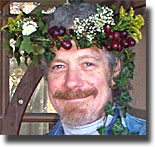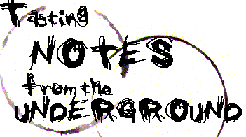|
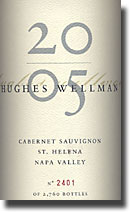 2005 Hughes-Wellman Napa Cabernet Sauvignon St. Helena, 14.5% alc., $50:
This deeply colored Cabernet is for those who like theirs lush, ripe (but not
super-ripe) and liberally dosed with oak; it walks a fine line between being
too-too and not-quite-over the top. Kim is somewhat put off by these qualities
and an initial “green-ness” that she says morphs into dill. I get some dill too,
but well in the background, with the rich, well-structured black currant and
blackberry setting the tone for the wine’s character. With some air, the oak on
the nose evolves into a sea air kind of thing, and the wine works well (believe
it or not) with a smoked chicken stir-fry. Another saving grace is the sleek,
elegant personality, and while it is made in a style that I don’t usually favor,
it has so many more plusses than minuses, I can’t help but like it. I’d like to
try it again in three to five years, and the price tag doesn’t bother me a bit,
considering what’s in the bottle. Find this wine 2005 Hughes-Wellman Napa Cabernet Sauvignon St. Helena, 14.5% alc., $50:
This deeply colored Cabernet is for those who like theirs lush, ripe (but not
super-ripe) and liberally dosed with oak; it walks a fine line between being
too-too and not-quite-over the top. Kim is somewhat put off by these qualities
and an initial “green-ness” that she says morphs into dill. I get some dill too,
but well in the background, with the rich, well-structured black currant and
blackberry setting the tone for the wine’s character. With some air, the oak on
the nose evolves into a sea air kind of thing, and the wine works well (believe
it or not) with a smoked chicken stir-fry. Another saving grace is the sleek,
elegant personality, and while it is made in a style that I don’t usually favor,
it has so many more plusses than minuses, I can’t help but like it. I’d like to
try it again in three to five years, and the price tag doesn’t bother me a bit,
considering what’s in the bottle. Find this wine
~
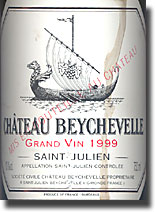 Me
and Chateau Beychevelle go back to 1977 or thereabouts. At the time, it
sold for around $12 in Michigan, an attractive tag, given the state of current
prices. This particular bottle was the oldest of a vertical going forward to the
2004 vintage that I tasted through recently, and was the one that I found most
interesting, no doubt due to its age. Our host gifted me with the 1/3 bottle
left, so I brought it home and got to know it a little better. (It should be
noted that all vintages tasted on this occasion showed remarkably similar
traits; this one was simply the most mature.) Me
and Chateau Beychevelle go back to 1977 or thereabouts. At the time, it
sold for around $12 in Michigan, an attractive tag, given the state of current
prices. This particular bottle was the oldest of a vertical going forward to the
2004 vintage that I tasted through recently, and was the one that I found most
interesting, no doubt due to its age. Our host gifted me with the 1/3 bottle
left, so I brought it home and got to know it a little better. (It should be
noted that all vintages tasted on this occasion showed remarkably similar
traits; this one was simply the most mature.)
1999 Chateau Beychevelle Saint-Julien, 13% alc.: Just a hint of bricking to the
good dark color of this one; toast and coffee flavors and aromas set the tone
here, with earthy black currant and cassis playing the rock-steady bass notes.
Softer and much more approachable than the 2000, ’02, ’03 and ’04 tasted on the
same occasion, but by no means close to optimum drinking. The still-significant
tannic structure needs at least five, and perhaps as much as ten years to
resolve, so there’s no reason to be in any hurry to open one of these now. Find this wine
Imported by Veritas Distributors, Inc., Warren, MI
 1989
Chateau Clerc Milon Pauillac, 13% alc.: Mellow, rich and perfectly mature,
this is showing some moderate bricking to the good, dark color. It offers earthy
black currant and beet root shaded with seamlessly integrated leather and
tobacco. Smooth and elegant, and still with good underlying structure, so this
is in no danger of fading any time soon, and it makes a perfect match for a
well-marbled rib eye steak grilled medium rare. Find this wine 1989
Chateau Clerc Milon Pauillac, 13% alc.: Mellow, rich and perfectly mature,
this is showing some moderate bricking to the good, dark color. It offers earthy
black currant and beet root shaded with seamlessly integrated leather and
tobacco. Smooth and elegant, and still with good underlying structure, so this
is in no danger of fading any time soon, and it makes a perfect match for a
well-marbled rib eye steak grilled medium rare. Find this wine
Imported by The Stacole Co. Inc., Boca Raton, FL
~
Here’s a mixed bag of some of the others we’ve had lately, starting with an old
favorite.
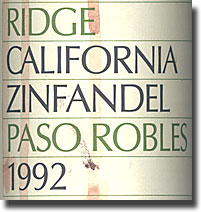 1992
Ridge Paso Robles Zinfandel, 14.9% alc.: Only showing a hint of bricking to
the deep, dark color, this old friend is still showing rich, ripe Draper
perfume, accented with some secondary notes of mahogany, cedar, earth and a
little stewed tomato, all of which echoes and expands on the palate, offering an
interesting juxtaposition between the ripeness of the fruit and the funkier
tertiary aspects that become more pronounced with air. The fruit and perfume is
all about raspberry and black raspberry graced with a kiss of soft apple pie
spices, and there’s also a note of brett that Kim likes even more than I do.
This is still holding up quite well, though it’s perhaps a little past its prime
if you’re looking for more ripe fruit and less secondary action. Many thanks to
Kurt “Indiana” Wieneke for this fine bottle of real Zinfandel, which we hadn’t
had the pleasure of enjoying since
the summer of 2001.
Find this wine 1992
Ridge Paso Robles Zinfandel, 14.9% alc.: Only showing a hint of bricking to
the deep, dark color, this old friend is still showing rich, ripe Draper
perfume, accented with some secondary notes of mahogany, cedar, earth and a
little stewed tomato, all of which echoes and expands on the palate, offering an
interesting juxtaposition between the ripeness of the fruit and the funkier
tertiary aspects that become more pronounced with air. The fruit and perfume is
all about raspberry and black raspberry graced with a kiss of soft apple pie
spices, and there’s also a note of brett that Kim likes even more than I do.
This is still holding up quite well, though it’s perhaps a little past its prime
if you’re looking for more ripe fruit and less secondary action. Many thanks to
Kurt “Indiana” Wieneke for this fine bottle of real Zinfandel, which we hadn’t
had the pleasure of enjoying since
the summer of 2001.
Find this wine
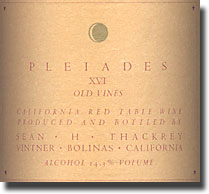 Sean
Thackrey Pleiades XVI, 14.3% alc., $24: The current edition of Sean
Thackrey’s kitchen sink catch-all red blend included Syrah, Barbera, Carignane,
Petite Sirah, Sangiovese and Viognier, “to name but a few,” as he puts it on the
side label, and it quite lives up to its lofty status as one of Kim’s favorite wines.
Ruby garnet in color, it exudes aromatics of pretty root beer, cola, black
raspberry, wood smoke and a hint of chocolate, all of which carries over onto
the palate, where the fruit turns a little spicy. With a somewhat velvety,
almost voluptuous texture, this is certainly not lacking in structure, but the
tannins are silky, the acids are perfectly balanced and there’s nice length on
the finish. This is just a pleasure to sip, with or without food, and these have
a good track record for aging. Find this wine Sean
Thackrey Pleiades XVI, 14.3% alc., $24: The current edition of Sean
Thackrey’s kitchen sink catch-all red blend included Syrah, Barbera, Carignane,
Petite Sirah, Sangiovese and Viognier, “to name but a few,” as he puts it on the
side label, and it quite lives up to its lofty status as one of Kim’s favorite wines.
Ruby garnet in color, it exudes aromatics of pretty root beer, cola, black
raspberry, wood smoke and a hint of chocolate, all of which carries over onto
the palate, where the fruit turns a little spicy. With a somewhat velvety,
almost voluptuous texture, this is certainly not lacking in structure, but the
tannins are silky, the acids are perfectly balanced and there’s nice length on
the finish. This is just a pleasure to sip, with or without food, and these have
a good track record for aging. Find this wine
2000 Sean Thackrey Mendicino Sangiovese Eaglepoint Ranch Aquila, 14.3% alc.:
Showing good dark color with no rust as of yet, this seems to be in something of
a middle period at first, being somewhat leathery, with toned down red currant
and beet root flavors and aromas; however, it responds well to aeration,
becoming more and more harmonious. This has come a long way since
Thackrey was
selling mailing list members bottles with no labels and calling it
“Centaur,” and it’s really in a nice place right now, but a few more years
shouldn’t hurt it at all. Find this wine
2006 Boekenhoutskloof The Chocolate Block, 55% Syrah, 17% Grenache Noir, 15%
Cinsault, 9% Cabernet Sauvignon, 4% Viognier, 14.83% alc., $32.99: This wine
shows good dark color, but that’s about the best I can say for it. I don’t know
what the “chocolate” refers to, because this wine is all heavy oak char that
obscures and ruins what seems to be some pretty nice deep, dark black fruit
underneath it all; in fact, for me, it comes off like tar, burnt toast and black
coffee, which doesn’t strike me as particularly appetizing. I’m not sure why
anyone would want to drink this now, but who knows, five years or more might
make a difference. An older model might add some insight as to what this might
develop into, but I don’t have the advantage of that perspective at this time.
Find this wine
Imported by Vineyard Brands, Inc., Birmingham, AL
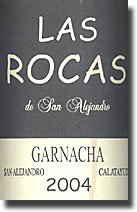 2004
Las Rocas de San Alejandro Garnacha Calatayud, 14.5% alc., $10.99: Rich dark
color, with bright, rich, ripe (right on the edge of what I can tolerate without
going over the line) dark plum, berry and cherry flavors and aromas offset by
big earthy bass notes; opens nicely with just a little as, with the ripeness
coming to the fore and a hint of chocolate emerging. Full bodied, but not heavy,
with the good structure to stand up to hearty food, while not interfering in the
least with the sheer drinking enjoyment. I like this wine a lot; it’s in a good
place right now and the quality of fruit from the 70-100 year old vines is all
but unmatched at this price point. Find this wine 2004
Las Rocas de San Alejandro Garnacha Calatayud, 14.5% alc., $10.99: Rich dark
color, with bright, rich, ripe (right on the edge of what I can tolerate without
going over the line) dark plum, berry and cherry flavors and aromas offset by
big earthy bass notes; opens nicely with just a little as, with the ripeness
coming to the fore and a hint of chocolate emerging. Full bodied, but not heavy,
with the good structure to stand up to hearty food, while not interfering in the
least with the sheer drinking enjoyment. I like this wine a lot; it’s in a good
place right now and the quality of fruit from the 70-100 year old vines is all
but unmatched at this price point. Find this wine
Imported by European Cellars LLC, Charlotte, NC
2006 William Fevre Chablis, 12.5% alc., $23,99: Medium straw in color,
with the requisite stony limestone character right up front in both flavor and
aroma, with a nice rich core of apple and pear fruit rounding things out and
some sea air on the nose. Good weight, with nice cut and length; not too complex
and still young, so it needs a year or three to develop. Find this wine
Imported by Henriot Inc., New York, NY
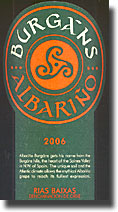 2006
Burgans Albarino Rias Baixas, 12.5% alc, $9.89:
This is one of our go-to whites so far this spring and summer, and why not,
at the great Costco price?! A rich medium straw in color, with a pretty, faintly
floral nose; rich and intense on the palate, with a mélange of tree and tropical
fruit flavors reminiscent of peach, apple, pear, grapefruit lime and kiwi. Good
weight, plenty of zippy acidity and just a lot of appealing personality. Riper
and richer than many Albarinos that we’ve had, and with less minerality, but it
works so well for us that we’ve already worked our way through one case, and we
might go through another before July is out. Find this wine 2006
Burgans Albarino Rias Baixas, 12.5% alc, $9.89:
This is one of our go-to whites so far this spring and summer, and why not,
at the great Costco price?! A rich medium straw in color, with a pretty, faintly
floral nose; rich and intense on the palate, with a mélange of tree and tropical
fruit flavors reminiscent of peach, apple, pear, grapefruit lime and kiwi. Good
weight, plenty of zippy acidity and just a lot of appealing personality. Riper
and richer than many Albarinos that we’ve had, and with less minerality, but it
works so well for us that we’ve already worked our way through one case, and we
might go through another before July is out. Find this wine
Imported by European Cellars LLC, Charlotte, NC
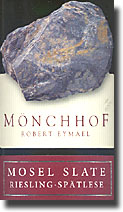 2006 Mönchhof Robert Eymael Riesling Spätlese Mosel Slate, $16.99, 9.5% alc.:
Medium straw in color, with rich, almost unctuous apricot, ripe apple, honey
and mineral flavors and aromas, shaded with some nice minerality underneath. The
depth of fruit is matched by the bracing acidity, which bodes well for several
years of development, but I’m already having a hard time keeping hands off,
especially at the Costco price listed here. Find this wine 2006 Mönchhof Robert Eymael Riesling Spätlese Mosel Slate, $16.99, 9.5% alc.:
Medium straw in color, with rich, almost unctuous apricot, ripe apple, honey
and mineral flavors and aromas, shaded with some nice minerality underneath. The
depth of fruit is matched by the bracing acidity, which bodes well for several
years of development, but I’m already having a hard time keeping hands off,
especially at the Costco price listed here. Find this wine
Imported by Cellars International, Inc., San Marcos, CA
~After
being wowed by the wines of Left
Foot Charley last year (and buying accordingly), we’d been
waiting anxiously for the latest offerings from Bryan
Ulbrich’s Traverse City, Michigan winery to make their way
down to us, and in fact, we missed out on the first batch, so when we caught
wine of the second, we didn’t hesitate to grab a case of each for our retail
outlet just to get our hands on some for ourselves. I’m happy to report that we
weren’t disappointed in the least with what we tasted.
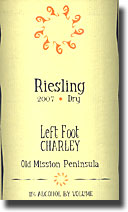 2007
Left Foot Charley Old Mission Peninsula Dry Riesling, 11% alc., $16: Very
pale, with just enough color to say that it has some; exudes a pretty Riesling
perfume on the nose, followed by rich Granny Smith green apple flavors and a
note of lime, with enough minerality to add complexity, interest and, for me, a
necessary element for the variety to be appealing. Good medium weight, excellent
cut and nice length make for a worthy successor to the fine 2004 version that we
went through several bottles of. This has a little more oomph than the ’07 7th
Hill bottling, which is flowery and almost delicate by comparison. Find this wine 2007
Left Foot Charley Old Mission Peninsula Dry Riesling, 11% alc., $16: Very
pale, with just enough color to say that it has some; exudes a pretty Riesling
perfume on the nose, followed by rich Granny Smith green apple flavors and a
note of lime, with enough minerality to add complexity, interest and, for me, a
necessary element for the variety to be appealing. Good medium weight, excellent
cut and nice length make for a worthy successor to the fine 2004 version that we
went through several bottles of. This has a little more oomph than the ’07 7th
Hill bottling, which is flowery and almost delicate by comparison. Find this wine
2007 Left Foot Charley Old Mission Peninsula Riesling 7th Hill Vineyard, 11%
alc., $18: Pale to medium straw in color, slightly floral on the nose and
somewhat sweet in the mouth, with ripe red and green apple flavors, and a China
Doll delicacy reminiscent of the
2006 model. Medium bodied, with very good
acidity, good rich depth of fruit and an ever-so-subtle underlying minerality.
Provides an interesting contrast to the dry Riesling noted directly above, and
drinks quite well with or without food, with enough cut to develop and age for
at least a few years. Find this wine
2007 Left Foot Charley Old Mission Peninsula Pinot Grigio, 12% alc., $16:
Pale straw color, with green melon and green apple flavors and aromas, followed
up with some minerality on the back end. Medium bodied and then some, with good
acids and length; not terribly complex, but then this is Pinot Grigio, and the
rich core of ripe fruit has palate coating concentration that works quite well
with just about any kind of fish you can pull out of a northern Michigan lake,
and that works just fine for me. Find this wine
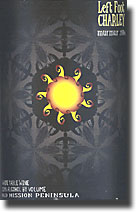 2006
Left Foot Charley Old Mission Peninsula Murmer, 11.5% alc., $15: A blend of
Riesling, Pinot Grigio and Pinot Blanc, this pale to medium straw colored wine
gives an immediate semi-sweet impression (has to be from the Riesling), with
ripe red apple on entry, then morphing into less ripe green apple and pear at it
progresses through the through the mid-palate, finally finishing semi-dry (yes,
there is a difference). Medium weight with good cut and length, and an
interestingly different blend. The Riesling (50%) comes from the Reehorst
vineyards, the Grigio (40%) comes from the Ligon Vineyard, and the Blanc (10%)
comes from the Island View Vineyard. Find this wine 2006
Left Foot Charley Old Mission Peninsula Murmer, 11.5% alc., $15: A blend of
Riesling, Pinot Grigio and Pinot Blanc, this pale to medium straw colored wine
gives an immediate semi-sweet impression (has to be from the Riesling), with
ripe red apple on entry, then morphing into less ripe green apple and pear at it
progresses through the through the mid-palate, finally finishing semi-dry (yes,
there is a difference). Medium weight with good cut and length, and an
interestingly different blend. The Riesling (50%) comes from the Reehorst
vineyards, the Grigio (40%) comes from the Ligon Vineyard, and the Blanc (10%)
comes from the Island View Vineyard. Find this wine
Reporting from Day-twah,
geo t.

Other Recent Wine Explorations
Red Wings and Red
Rhônes
Playoff Diary 2008
WELCOME HOME STANLEY!!!
21 ’06 Burgs – 2nd Day Air
Red Wings and Red
Rhônes
Playoff Diary 2008-Round 3
Red Wings and Red Rhônes
Playoff Diary 2008-Round 2
Red Wings and Red
Rhônes
Playoff Diary 2008-Round 1
Old Friends-New
Vintages
14 from Vietti
This and That
Brian Loring Comes
to Town
Back to the July 2008 Index
Back to the Underground Index
Back to the Top


© George Heritier July, 2008
|
 Me
and Chateau Beychevelle go back to 1977 or thereabouts. At the time, it
sold for around $12 in Michigan, an attractive tag, given the state of current
prices. This particular bottle was the oldest of a vertical going forward to the
2004 vintage that I tasted through recently, and was the one that I found most
interesting, no doubt due to its age. Our host gifted me with the 1/3 bottle
left, so I brought it home and got to know it a little better. (It should be
noted that all vintages tasted on this occasion showed remarkably similar
traits; this one was simply the most mature.)
Me
and Chateau Beychevelle go back to 1977 or thereabouts. At the time, it
sold for around $12 in Michigan, an attractive tag, given the state of current
prices. This particular bottle was the oldest of a vertical going forward to the
2004 vintage that I tasted through recently, and was the one that I found most
interesting, no doubt due to its age. Our host gifted me with the 1/3 bottle
left, so I brought it home and got to know it a little better. (It should be
noted that all vintages tasted on this occasion showed remarkably similar
traits; this one was simply the most mature.) 2007
Left Foot Charley Old Mission Peninsula Dry Riesling, 11% alc., $16: Very
pale, with just enough color to say that it has some; exudes a pretty Riesling
perfume on the nose, followed by rich Granny Smith green apple flavors and a
note of lime, with enough minerality to add complexity, interest and, for me, a
necessary element for the variety to be appealing. Good medium weight, excellent
cut and nice length make for a worthy successor to the fine 2004 version that we
went through several bottles of. This has a little more oomph than the ’07 7th
Hill bottling, which is flowery and almost delicate by comparison. Find this wine
2007
Left Foot Charley Old Mission Peninsula Dry Riesling, 11% alc., $16: Very
pale, with just enough color to say that it has some; exudes a pretty Riesling
perfume on the nose, followed by rich Granny Smith green apple flavors and a
note of lime, with enough minerality to add complexity, interest and, for me, a
necessary element for the variety to be appealing. Good medium weight, excellent
cut and nice length make for a worthy successor to the fine 2004 version that we
went through several bottles of. This has a little more oomph than the ’07 7th
Hill bottling, which is flowery and almost delicate by comparison. Find this wine 2006
Left Foot Charley Old Mission Peninsula Murmer, 11.5% alc., $15: A blend of
Riesling, Pinot Grigio and Pinot Blanc, this pale to medium straw colored wine
gives an immediate semi-sweet impression (has to be from the Riesling), with
ripe red apple on entry, then morphing into less ripe green apple and pear at it
progresses through the through the mid-palate, finally finishing semi-dry (yes,
there is a difference). Medium weight with good cut and length, and an
interestingly different blend. The Riesling (50%) comes from the Reehorst
vineyards, the Grigio (40%) comes from the Ligon Vineyard, and the Blanc (10%)
comes from the Island View Vineyard. Find this wine
2006
Left Foot Charley Old Mission Peninsula Murmer, 11.5% alc., $15: A blend of
Riesling, Pinot Grigio and Pinot Blanc, this pale to medium straw colored wine
gives an immediate semi-sweet impression (has to be from the Riesling), with
ripe red apple on entry, then morphing into less ripe green apple and pear at it
progresses through the through the mid-palate, finally finishing semi-dry (yes,
there is a difference). Medium weight with good cut and length, and an
interestingly different blend. The Riesling (50%) comes from the Reehorst
vineyards, the Grigio (40%) comes from the Ligon Vineyard, and the Blanc (10%)
comes from the Island View Vineyard. Find this wine
